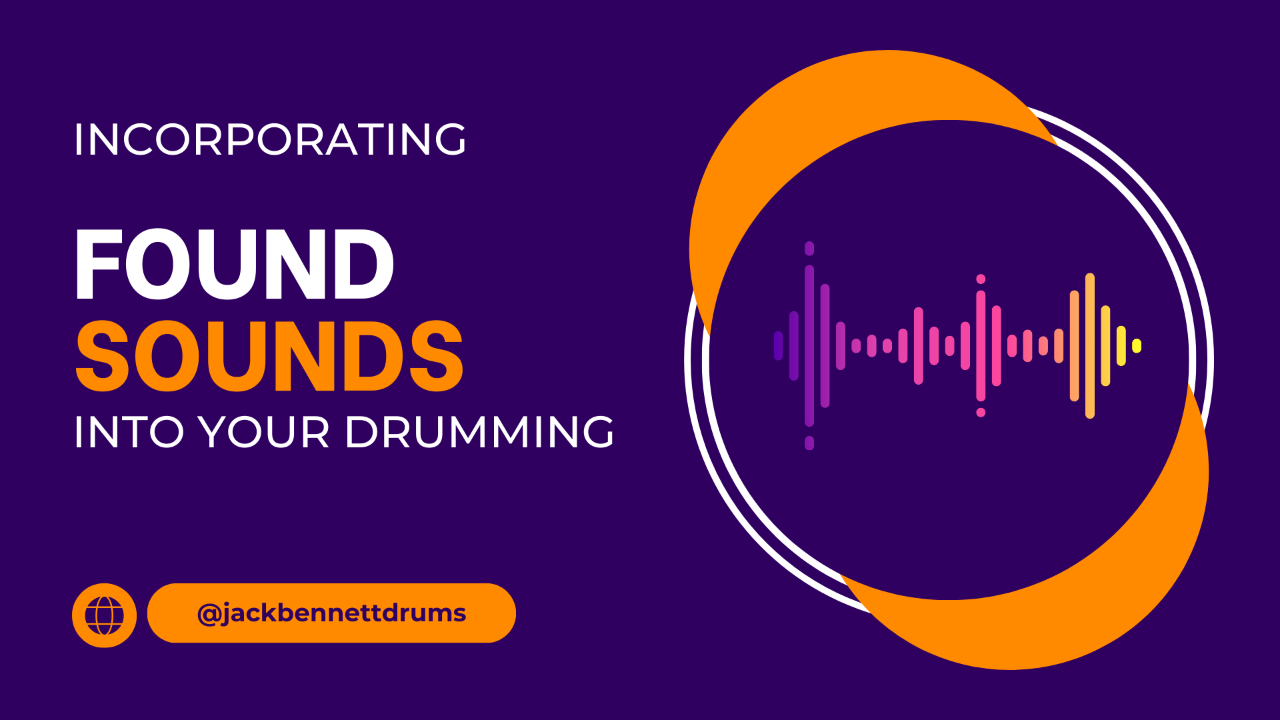How to Incorporate Found Sounds & Unconventional Objects into Drumming
Apr 27, 2025
How to Incorporate Found Sounds & Unconventional Objects into Drumming
In the world of drumming, creativity knows no bounds. One of the most exciting ways to expand your sound palette and break out of traditional molds is by incorporating found sounds and unconventional objects into your drumming. From street performances to avant-garde recordings, artists have long used everyday items to create compelling rhythms and textures. In this article, we'll dive deep into how you can bring found sounds into your playing, offering practical tips, creative ideas, and inspiration to help you push the boundaries of percussion.
What Are Found Sounds?
Found sounds are non-traditional noises captured from everyday objects or environments. This could include tapping on a coffee can, scraping a metal fence, slamming a car door, or shaking a bag of coins. Essentially, it’s using the world around you as a massive percussion playground.
Found sounds aren't limited to recording studios; they can be incorporated into live drumming performances, hybrid kits, and even acoustic sets. They bring uniqueness, texture, and often an element of surprise to your music.
Why Use Found Sounds?
-
Expand Your Sonic Palette: Traditional drums have a wide but defined range of sounds. Found sounds open up endless new tones.
-
Creativity Boost: Working with unconventional materials forces you to think differently about rhythm and timbre.
-
Affordability: You don’t need expensive gear. Often, items you already own can become part of your setup.
-
Artistic Statement: Incorporating found sounds can make a strong artistic impact, emphasizing innovation and originality.
Getting Started: Finding Your Sounds
Start by exploring your environment. Kitchens, garages, junkyards, thrift stores, and nature all offer potential treasures.
Some Ideas for Found Percussion Items:
-
Kitchenware: Pots, pans, whisks, colanders, baking sheets
-
Construction Materials: PVC pipes, metal sheets, wooden planks
-
Street Objects: Trash cans, metal fences, manhole covers
-
Office Supplies: Paper clips, staplers, notebooks
-
Natural Elements: Sticks, stones, leaves, water buckets
-
Household Items: Buckets, laundry baskets, plastic containers
The key is experimentation. Hit it, scrape it, shake it, or rub it—see what kinds of sounds you can generate.
Integrating Found Sounds Into Your Setup
You can incorporate found sounds in multiple ways, depending on your setup and the vibe you're aiming for.
1. As Add-ons to Your Drum Kit
-
Attach or mount found objects onto your kit.
-
Place metal objects on top of snares for a metallic buzz.
-
Replace or complement hi-hats with stacked items like plates or cymbals with coins glued onto them.
2. Standalone Percussion Stations
-
Create a "junk percussion" station with a table or rig dedicated to found objects.
-
Use triggers and pads to blend acoustic found sounds with electronic samples.
3. Handheld or Foot-Operated Sounds
-
Use foot pedals to strike buckets, metal bars, or other objects.
-
Play small objects by hand during quieter, more textural parts of songs.
Techniques for Playing Unconventional Objects
Different objects will require different approaches:
-
Sticks vs. Brushes: Hard sticks produce sharp attacks; brushes or soft mallets create softer textures.
-
Scraping: Scraping metal or wood creates a gritty, rhythmic layer.
-
Shaking: Objects filled with small items (beans, pebbles) can function like shakers.
-
Muting: Pressing an object while striking it can change its pitch or resonance.
-
Dampening or Amplifying: Add cloth to deaden a sound or use a mic to bring out subtler textures.
Recording Found Sounds
If you want to incorporate found sounds into your recordings, you can:
-
Record directly with a field recorder or smartphone.
-
Layer recorded found sounds into drum parts.
-
Use sampling software to manipulate and trigger found sounds.
Experiment with EQ, reverb, and effects to transform raw recordings into usable textures.
Creative Applications
Found sounds can fit into many musical contexts, from ambient soundscapes to high-energy rock beats.
1. Intro Sections
Start a song with a found sound groove to set a unique tone.
2. Textural Overlays
Layer subtle found sounds underneath traditional drum parts to add richness.
3. Full Rhythmic Foundations
Use a complete found object setup to replace or augment a standard drum kit in live performance or recordings.
4. Sound Collages and Interludes
Create experimental pieces or interludes using only found sounds for a break in an album or live show.
Challenges and Tips
1. Sound Consistency
Found sounds can be inconsistent in volume and tone. Use careful mic placement and consider reinforcing fragile objects.
2. Playability
Make sure your objects are playable in a live setting. Stability and ease of access are key.
3. Audience Engagement
Visually unusual instruments can be a crowd-pleaser—lean into that! Showcase your creativity with how you play and present your found sounds.
4. Transport and Setup
Be mindful of the logistics. Found objects can be heavy, fragile, or awkward to transport.
Notable Artists Who Use Found Sounds
-
Stomp: The world-renowned percussion group uses brooms, trash cans, matchboxes, and more to create rhythmic spectacles.
-
Trilok Gurtu: This Indian percussionist integrates water buckets, cooking utensils, and various found sounds into his performances.
-
Evelyn Glennie: A groundbreaking percussionist known for using unconventional objects in classical and avant-garde compositions.
-
Questlove (The Roots): Occasionally integrates non-traditional elements into his live and recorded drumming.
Final Thoughts
Incorporating found sounds and unconventional objects into drumming is an exhilarating journey into the limitless possibilities of rhythm and tone. It challenges you to think outside the traditional drum kit, taps into your imagination, and adds a personal, unique signature to your music.
Whether you're seeking new textures for your recordings, adding intrigue to your live performances, or just having fun exploring new sonic territory, found sounds offer endless potential. So start exploring—your next great "drum" might just be sitting on your kitchen counter or hiding at your local thrift shop.

